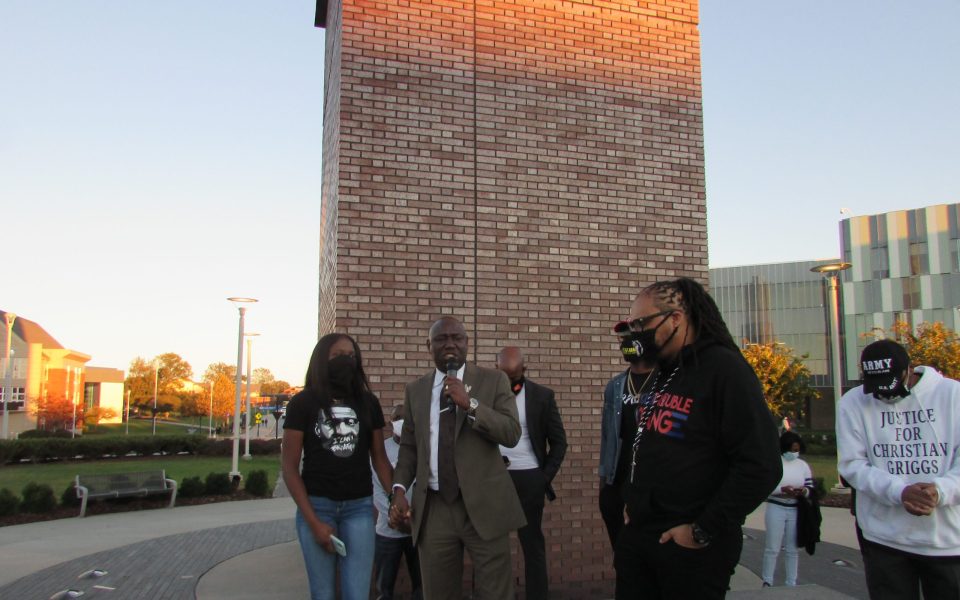Civil rights attorney Benjamin Crump grasps the hand of Brooke Williams, the niece of George Floyd, as the Rev. Greg Drumwright looks on. (photo by Jordan Green)
Black Lives Matter protesters under the leadership of the Rev. Greg Drumwright marched to the polling place at NC A&T University in Greensboro on the last day of early voting.
Lifting up the names of George Floyd, Breonna Taylor, Armaud Arbery, Sandra Bland and Marcus Deion Smith, about 100 people marched from Governmental Plaza about 10 blocks east to the A&T campus. But instead of going directly to the polling place at Dudley Memorial Building, they continued on through the heart of campus, stopping to pay tribute to Willie Grimes, an A&T student who was killed during the National Guard occupation in 1969, and gathering for speeches at the Deese Clock Tower.
Greensboro police blocked the streets, but the march had its own security detail — a handful of people protecting the rear flank and equipped with helmets, chest plates and radios. Although the march went smoothly, the potential for interference was impossible to ignore considering President Trump’s call for his supporters to monitor polling places for fabricated claims of voter fraud and right-wing hostility towards Black Lives Matter.
The event at A&T, the nation’s largest historically Black university, featured civil rights attorney Benjamin Crump, who represents the families of George Floyd, Breonna Taylor and Jacob Blake, along with many other victims of police violence. Brooke Williams, Floyd’s niece, also spoke, along with state Rep. Erica Smith and 102 JAMZ on-air personality Brian “B-Daht” McLaughlin.
“We’ve got to go vote like our children’s lives depend on it, because George Floyd’s blood is on the ballot,” Crump said. “Breonna Taylor’s blood is on the ballot. Armaud Arbery’s blood is on the ballot. Jacob Blake’s blood is on the ballot. Trayvon Martin’s blood is on the ballot.”
The Greensboro march on Friday was the first of a pair, setting the stage for a companion march to the polling place at the Alamance County Office Annex Building in Graham taking place today, the final day of early voting. Three days remain until Election Day on Tuesday.
Drumwright said he has been frustrated by lack of cooperation from the Graham police on their plans to march past the Historic Courthouse, the site of a Confederate monument that has been the target of protest.
“They’re going to escort us downtown, but they won’t stop traffic, and they won’t allow us to erect a stage so we can speak,” Drumwright said. “They want to keep traffic going around the courthouse square while we’re on the sidewalks.”
The rally at Deese Clock Tower at about 6:45 p.m., and a smaller group marched back to Dudley Memorial Building to vote.
Drumwright was the first in line.
A handful of people from the protest group voted; at least two were turned away because they were not residents of Guilford County.
As of Thursday, 5,170 people had voted at the A&T polling place, one of 25 across Guilford County that have collected a combined 169,769 votes over the same period. Including absentee ballots, 212,442 have voted in Guilford County as of Thursday, accounting for 56.7 percent of registered voters. Of the 46,037 mail ballots returned in Guilford, 1,346, or 2.9 percent, have been set aside because of deficiencies. Mail ballots cast by Black voters in Guilford County are almost three times more likely to be rejected than those cast by white voters.
“I wanted to be part of this movement,” said 42-year-old Woodraille Gilchrist, who voted at A&T on Friday. “My family members have attended A&T. It’s homecoming weekend. I wouldn’t miss it for anything.”
Gilchrist said her interests haven’t changed since the last election: It’s dismantling the racial caste system “by any means necessary.”
Join the First Amendment Society, a membership that goes directly to funding TCB‘s newsroom.
We believe that reporting can save the world.
The TCB First Amendment Society recognizes the vital role of a free, unfettered press with a bundling of local experiences designed to build community, and unique engagements with our newsroom that will help you understand, and shape, local journalism’s critical role in uplifting the people in our cities.
All revenue goes directly into the newsroom as reporters’ salaries and freelance commissions.


Leave a Reply